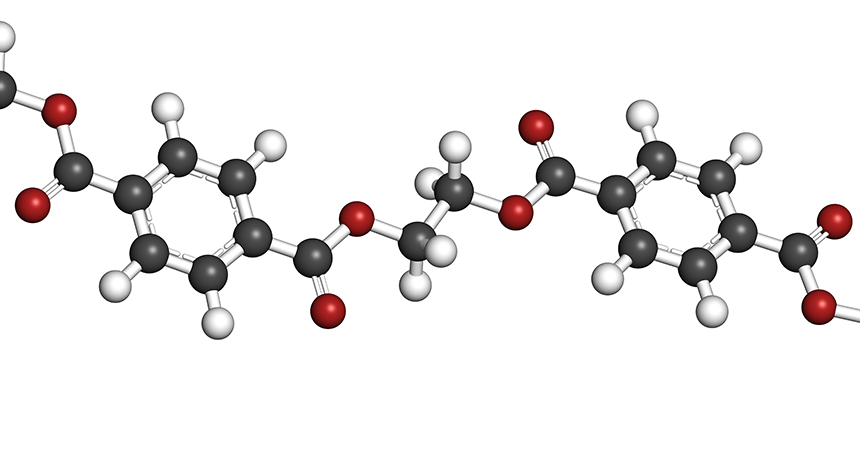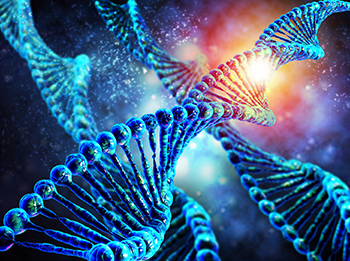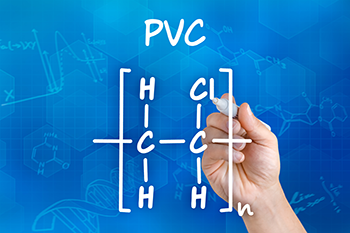Explainer: What are polymers?
These materials, many of them artificial, are built from repeating chains of smaller chemical units

Polymers, whether artificial (such as the plastic shown) or natural, are made of repeating chains of smaller chemical units. Here, carbon atoms are shown as black, oxygen as red and hydrogen as white.
Molekuul/iStockphoto
By Sid Perkins
Polymers are everywhere. Just look around. Your plastic water bottle. The silicone rubber tips on your phone’s earbuds. The nylon and polyester in your jacket or sneakers. The rubber in the tires on the family car. Now take a look in the mirror. Many proteins in your body are polymers, too. Consider keratin (KAIR-uh-tin), the stuff your hair and nails are made from. Even the DNA in your cells is a polymer.
By definition, polymers are large molecules made by bonding (chemically linking) a series of building blocks. The word polymer comes from the Greek words for “many parts.” Each of those parts is scientists call a monomer (which in Greek means “one part”). Think of a polymer as a chain, with each of its links a monomer. Those monomers can be simple — just an atom or two or three — or they might be complicated ring-shaped structures containing a dozen or more atoms.
In an artificial polymer, each of the chain’s links will often be identical to its neighbors. But in proteins, DNA and other natural polymers, links in the chain often differ from their neighbors.

In some cases, polymers form branching networks rather than single chains. Regardless of their shape, the molecules are very big. They are so big, in fact, that scientists classify them as macromolecules. Polymer chains can include hundreds of thousands of atoms — even millions. The longer a polymer chain, the heavier it will be. And, in general, longer polymers will give the materials made from them a higher melting and boiling temperature. Also, the longer a polymer chain, the higher its viscosity (or resistance to flow as a liquid). The reason: They have a greater surface area, which makes them want to stick to neighboring molecules.
Wool, cotton and silk are natural polymer-based materials that have been used since ancient times. Cellulose, the main component of wood and paper, also is a natural polymer. Others include the starch molecules made by plants. [Here’s an interesting fact: Both cellulose and starch are made from the same monomer, the sugar glucose. Yet they have very different properties. Starch will dissolve in water and can be digested. But cellulose doesn’t dissolve and can’t be digested by humans. The only difference between these two polymers is how the glucose monomers have been linked together.]
Living things build proteins — a particular type of polymer — from monomers called amino acids. Although scientists have discovered some 500 different amino acids, animals and plants use only 20 of them to construct their proteins.
In the lab, chemists have many options as they design and construct polymers. They may build artificial polymers from natural ingredients. Or they can use amino acids to build artificial proteins unlike any made by Mother Nature. More often, chemists create polymers from compounds made in the lab.
The anatomy of a polymer
Polymer structures can have two different components. All start with a basic chain of chemically bonded links. This is sometimes called its backbone. Some may also have secondary parts that dangle from some (or all) of the chain’s links. One of these attachments may be as simple as a single atom. Others may be more complex and referred to as pendant groups. That’s because these groups hang off the main chain of the polymer just as individual charms hang off the chain of a charm bracelet. Because they are exposed to the surroundings more than are the atoms that make up the chain itself, these “charms” often determine how a polymer interacts with itself and other things in the environment.
Sometimes pendant groups, instead of hanging loose from one polymer chain, actually connect two chains together. (Think of this as looking like a rung that stretches between the legs of a ladder.) Chemists refer to these ties as crosslinks. They tend to strengthen a material (such as a plastic) made from this polymer. They also make the polymer harder and more difficult to melt. The longer the crosslinks, however, the more flexible a material becomes.

A chemical bond is what holds atoms together in a molecule and some crystals. In theory, any atom that can form two chemical bonds can make a chain; it’s like needing two hands to link with other people to make a circle. (Hydrogen wouldn’t work because it can form only one bond.)
But atoms that typically form only two chemical bonds, such as oxygen, don’t often make long, polymer-like chains. Why? Once oxygen forms two bonds, it becomes stable. That means its two “outstretched hands” are already taken. None are left to hold a pendant group. Since many atoms that are part of a polymer’s backbone generally have at least one pendent group, the elements that typically appear in the polymer chain are ones that become stable with four bonds, such as carbon and silicon.
Some polymers are flexible. Others are very stiff. Just think of the many types of plastics: The material in a flexible soda bottle is very different from that in a rigid pipe made from polyvinyl chloride (PVC). Sometimes materials scientists add other things to their polymers to make them flexible. They’re called plasticizers. These take up space between individual polymer chains. Think of them as acting like a molecular-scale lubricant. They let the individual chains slide across each other more easily.
As many polymers age, they may lose plasticizers to the environment. Or, aging polymers may react with other chemicals in the environment. Such changes help explain why some plastics start out flexible but later become stiff or brittle.
Polymers don’t have a definite length. They usually don’t form crystals, either. Finally, they usually don’t have a definite melting point, at which they immediately switch from a solid into a pool of liquid. Instead, plastics and other materials made from polymers tend to soften gradually as they heat up.







